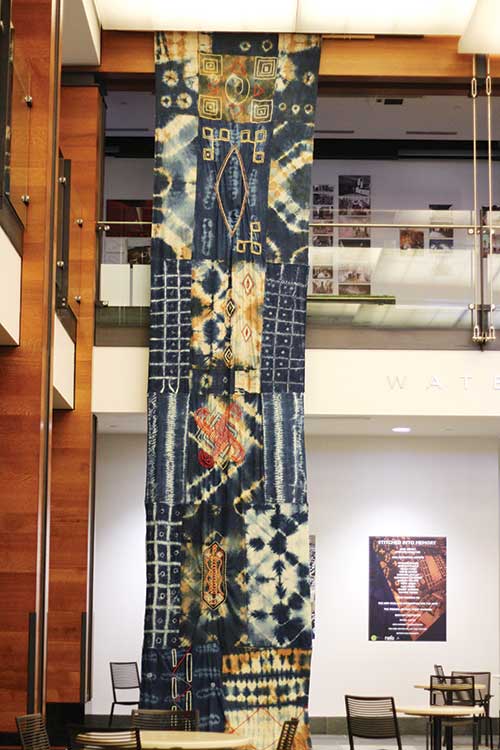The color of life: Stephen Hamilton revives African textile traditions


Author: PHOTO: CELINA COLBYArtist Stephen Hamilton’s 30-foot installation in the lobby of 290 Congress St. blends
together textiles made with traditional West African techniques.
In the polished lobby of 290 Congress Street hangs a 30-foot-tall African textile mural. Created by artist Stephen Hamilton in collaboration with nine Boston teenagers, the project revives and celebrates traditional West African indigo dyeing techniques.
“A lot of us in the Americas don’t think about how African cloth is made,” says Hamilton. “The idea of this project is to reclaim those artistic traditions.”
Hamilton worked with his teen collaborators for four months, teaching them the dyeing, weaving and embellishing processes. He explains that indigo dyeing is a significantly more laborious process than used for other dyes. But in the end, the dye becomes more brilliant and permanent than its counterparts.
History is just as important as artistry in Hamilton’s workshops. “I wanted them to feel the connection to Africa,” he says. “I wanted them to be able to touch and experience it.”
Indigo represents life in the Yoruba tradition and holds both spiritual and cultural weight.
But there’s a darker side to this brilliant color.
When enslaved African people were brought to the Americas, they took the knowledge of indigo dyeing with them. According to NPR, profits from indigo outperformed those of sugar and cotton in the 1700s.
Even the original American flag was made from indigo textiles.
Slave owners began trading human bodies for fabrics in that seductive blue. While dyeing was a mode of financial empowerment for African women, it only generated money for American slave owners.“The knowledge of processing indigo was exploited in slaves for generations,” says Hamilton. “Its permanence and brilliance were part of the reason it was such a valuable cash crop.”
Now, he’s taking that tradition back.
Hamilton grew up in Roxbury and says he frequented A Nubian Notion in Dudley Square to look at a book of works by black artists. This early exposure to traditional African art informed his artistic path going forward. He traveled to Nigeria to study for nine months at the Nike Center for Art and Culture, where he learned these art forms.
The textile mural sings with power and pride. Its mammoth scale makes it impossible to ignore. Smaller textiles are sewn together to make the full height of the piece, underscoring unity among the creators who all contributed a bit of themselves to the project.
The artwork’s placement tells a story as well. In the sleek lobby of the financial district office, “Stitched Into Memory” disrupts the corporate landscape and demands to be seen. Like indigo did for Yoruba tribes, the mural breathes life into its unfeeling surroundings of steel and chrome.




![Banner [Virtual] Art Gallery](https://baystatebanner.com/wp-content/uploads/2024/04/NJ-H_1-713x848.jpg)

